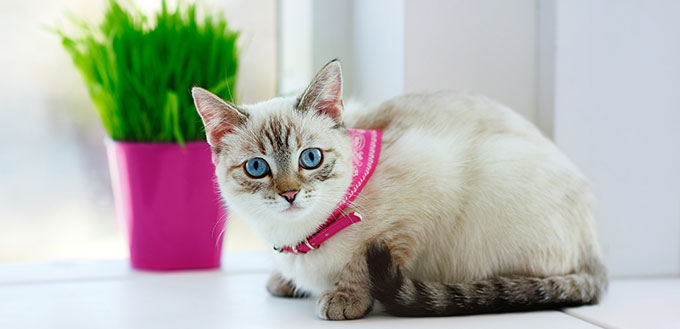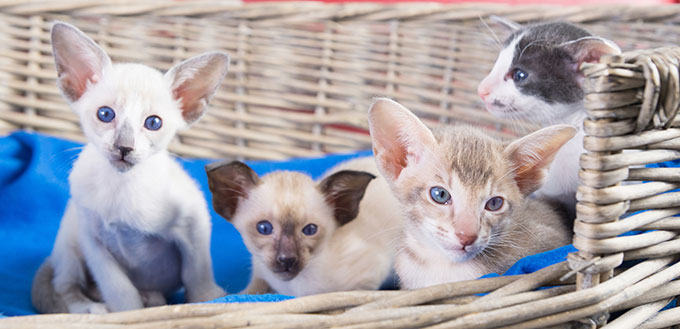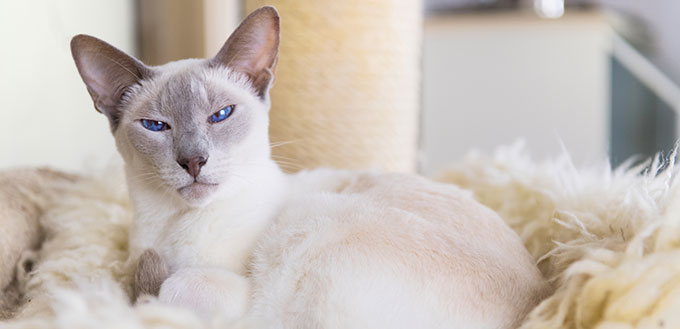The Colorpoint Shorthair is a loving and loyal feline. It has the friendly, affectionate, and sociable nature of the Siamese as well as the playfulness and the steadiness of an American Shorthair. They are attention-seekers. They will not hesitate to vocalize just to get your attention or if they feel unsatisfied about something. They are smart and can be very emotional in certain situations. The Colorpoint is never afraid to show its affectionate and funny side. Is this the right cat for you? Let’s find out.

History of the Colorpoint Shorthair
No one can tell the exact date or who created the very first Colorpoint Shorthair. What we know is that the breed is the result of combining a Siamese with either an American Shorthair or an Abyssinian cat. What is clear is that some cat breeders in the 1940s were not satisfied with the pointed colors of the Siamese. They sought to create a Siamese with a different color. This resulted in the creation of the Colorpoint Shorthair.
Major cat registries only recognize four Siamese pointed colors. These are seal point, chocolate, blue, and lilac. Seal point Siamese had dark brown points on a pale fawn body. Chocolate Siamese cats had light-brown points on a creamy white body. Blue Siamese cats come with grayish blue points with a bluish white body. Siamese cats with lilac colorpoints showed pinkish gray points on a white body.
Some American and British cat breeders wanted to create a different Siamese colorpoint. As such, they mated a seal point Siamese with a red American Shorthair with a tabby pattern. Some breeders also mated the Siamese to an Abyssinian cat. The resulting Colorpoint Shorthair cats were then bred back to a seal point Siamese. This is to help strengthen the qualities of the new Siamese cat. After all, the breeders only wanted a different colorpoint of the Siamese.
The initial results were far from satisfactory. Although they were able to create a different colorpoint of Siamese, the breeders had to sacrifice some of the unique physical attributes of the original Siamese. However, all is not lost. People began to take notice of the new colorpoint. People think that the reddish color of the new Siamese is adorable.
The Cat Fanciers’ Association started recognizing the Colorpoint as a different breed in the 1960s. In 1964, the cat registry advanced the red and cream Colorpoints to championship status. Five years later, the organization also elevated to championship status the tortie and lynx points of the Colorpoint.
Today, only two major cat registries recognize the Colorpoint Shorthair as a distinct breed. These include the World Cat Federation and the Cat Fanciers’ Association. Other cat registries consider the cat as another variant of the Siamese. There are also those that look at it as a hybrid cat, owing to the mixing of Siamese, Abyssinian, and American Shorthair in its creation.
Quick Facts About the Colorpoint Shorthair
Not everyone may agree that the Colorpoint Shorthair is a pedigreed cat. However, no one can deny the popularity of these kitties. Before you start shopping for a Colorpoint to bring home, however, it would be best to understand a few more basic facts about these kitties.
- Medium-Sized Kitty
The Colorpoint shares a lot of things with its cousin, the Siamese. Male Colorpoints are medium in size. They often weigh between 8 and 12 pounds. Female Colorpoints are smaller, often not exceeding 8 pounds.
They also have the characteristic wedge-shaped head of the Siamese. It also has tall ears that further accentuate the triangular shape of its head. It has a straight, albeit long nose. It has a slender, yet well-muscled body. Supporting the body are four slender and long legs. They also have a tail that has a characteristic point at the tip.
One of the most lovable physical characteristics of the Colorpoint is its eyes. They have a bright blue color that contrasts well with its original reddish point. They are also almond-shaped, lending a look of friendliness and sociability to the cat.
- A Siamese in a Different Color
As mentioned, the Colorpoint is a Siamese outside the traditional colorpoints of the breed. If you see a Siamese-looking cat not in chocolate, seal, blue, or lilac colorpoint, then it is a Colorpoint Shorthair.
The Colorpoint Shorthair can come in 16 different color varieties. There are the CFA standards red and cream solid points. There are also the lynx points and tortie points. The lynx point can come in different colors. These can include seal, chocolate, blue, lilac, red, cream, seal-tortie, chocolate-tortie, blue-cream, and lilac-cream. They can also come in parti-color points. These include seal-tortie, blue-cream, chocolate-tortie, and lilac-cream.
- Colorpoint Confusion
Keep in mind that only the CFA and the WCF consider the Colorpoint as a distinct feline breed. Other registries used the term “Colorpoint” to refer to cats that have Persians in their ancestry. They also call other pointed cats as Colorpoint. An example of this is the Himalayan.
- A Very Vocal Cat
The Siamese is a very vocal kitty. It is not surprising that the Colorpoint is also very vocal. It is not ashamed to use any of its 100 or so vocalizations to communicate its thoughts and feelings. This can be a real concern for people who live in apartment complexes. The sound coming from this cat can easily annoy the neighbors.
- Low-Shedding Cat
Many of the cats that have the Siamese cat in their genes have the potential to be low-shedding. This includes the Colorpoint. Do not think that it is already a good pet for people with asthma and other allergies. They still carry the same Fel d 1 allergen that is present in all cats. The only difference is that Siamese cats have lower concentrations of this allergen.
However, since the Colorpoint is a mixture of a Siamese and an American Shorthair or an Abyssinian, you can get a Colorpoint with varying levels of shedding potential. American Shorthairs are moderate shedders.
If the Colorpoint is the result of the crossbreeding of a Siamese and an American Shorthair, then you can expect a moderate-low shedding potential. The Abyssinian, on the other hand, is a low-shedding breed. Colorpoints with an Abyssinian parent tend to have a lower shedding potential than those born from an American Shorthair parent.

Things You Should Know
The Colorpoint Shorthair is as beautiful and affectionate as the Siamese. It can also have the playfulness of the American Shorthair or the intelligence and curiosity of the Abyssinian. Part of becoming the pet parent of this kitty is knowing how to care for it, including feeding, grooming, and its health.
Health
The Colorpoint Shorthair has an average life expectancy of about 12 to 16 years. However, it is not uncommon that there are some cats that can live up to 20 years. This feline breed is quite prone to a few health conditions, however. These can include sternal protrusion, retinal degeneration, and corneal sequestrum.
These are in addition to the diseases that are quite common among Siamese and other cats. These include hypertrophic cardiomyopathy, kidney disease, amyloidosis, crossed eyes, lymphoma, asthma, and megaesophagus.
In sternal protrusion, the cat’s sternum has an inward angle. This can compress the cat’s heart and lungs. It is a hereditary disease among Colorpoints. It is for this reason that one should be very careful when buying a Colorpoint kitten. One should only get kittens from a reputable breeder. Or, at the very least, ask the breeder to show you the health certificates of the kitten’s parents.
Retinal degeneration is almost similar to progressive retinal atrophy. It can lead to blindness of the cat. This can have a negative effect on the Colorpoint’s quality of life. The same is true with corneal sequestrum. The only difference between this disease and that of retinal conditions is that it is not a serious disease. Corneal sequestrum results in the formation of a pigmented lesion in the cornea of the Colorpoint’s eyes.
In addition to these health conditions, there are also anecdotal evidence showing the predisposition of Colorpoints to vaccine hypersensitivity. Some pet owners report that their Colorpoint cats became lethargic or developed fever right after receiving their vaccine shots. However, this should not be an excuse not to have the Colorpoint Shorthair vaccinated from the core feline diseases.
Another health condition that potential pet parents of Colorpoint Shorthairs should know is hyperesthesia syndrome. This is a neurological problem that results in excessive sensitivity to stimuli. This can lead the cat to lick, scratch, and bite certain body parts. It can result in hair loss and secondary bacterial infections.
Feeding
Colorpoint Shorthair cats are quite prone to obesity. That is why one should be careful to feed it only the required amounts of high-quality food. One should avoid free-feeding the cat as this can contribute to weight issues. It is best to feed the adult Colorpoint twice a day. Kittens can feed up to four times a day.
The best food for a Colorpoint Shorthair is high-quality canned cat food. It is more expensive than kibbles. However, it has less calories and carbohydrates than kibbles. It also contains more proteins on a dry matter basis. Remember that this cat is long and lean. It needs high-quality proteins to develop and maintain its muscles.
Water should also be a part of its feeding routine. This is regardless of the type of cat food that you give the Colorpoint. Pet drinking fountains work best in encouraging cats to drink more. If you’re on a tight budget, making sure that the cat has access to fresh, clean, and cool drinking water can help. Adding a few drops of chicken broth or the juice from a can of tuna can also help.
Related Posts: Best Wet Cat Food, Best Dry Cat Food and Best Cat Food for Weight Loss
Care
Like any other cat, the Colorpoint Shorthair deserves proper care. It needs to be both healthy and happy so that it can live its feline life to the fullest. One way you can ensure this is by bringing the cat to the vet on a regular basis. It needs a wellness exam every year that should also include routine health checks and screening tests. Also critical are core vaccination shots. One has to understand that there will always be side effects of these vaccinations. A veterinarian can help you manage these side effects, in case they arise.
Preventatives are also important in the care of Colorpoints. They need protection from fleas, ticks, and mites. They also need protection against heartworm and intestinal worms. There are formulations that can help provide such protections. If one is not keen on using synthetic preventatives, then he or she can use natural remedies. However, the results may not be as effective or as fast-acting as synthetic formulations.
Colorpoint Shorthair cats are also very playful and intelligent. They will do well with interactive cat toys as well as puzzle toys. They demand the attention of their owners and that of the other members of the family. If you cannot give them this attention, then they might develop behavioral problems. Colorpoints are very clingy. That is why they are also prone to separation anxiety. It is for this reason that owners should train these kitties at the soonest possible time. Leaving them with engaging and mentally stimulating playthings can also help.
Do not allow the Colorpoint Shorthair to stray outside the house. It may not be as expensive as the Persian or the Russian Blue but at an average price of $500 to $800, it can still net a handsome amount of money if it falls into the wrong hands. The outdoors is also littered with hazards. Harmful chemicals can get on the cat’s coat or paws. Moving vehicles can hit and injure the cat. Wild animals and other vicious creatures can also harm the cat. It is best to keep it indoors.
Part of the Colorpoint’s care is litter box training. Teaching it how to use the litter box is crucial as you don’t want the cat to conduct its ‘business’ anywhere else. Cleaning the litter box is, thus, important. One should remove clumped litter every day while giving the litter box a thorough cleaning every week. You should also invest in scratching pad and cat beds to make the Colorpoint Shorthair happy. Cat trees are also exceptional tools. This is a breed of cat that loves to climb and jump.
Grooming
Grooming the Colorpoint is not difficult. Its coat does not require very frequent brushing. It is low-shedding, too. Once weekly brushing of the coat is often enough. This will help remove dirt that may be on the cat’s fur. It can also facilitate the more even distribution of its natural oils.
Cleaning the ears is also important. Dirt can accumulate in the ears and lead to hearing difficulties. One should inspect the ears for signs of inflammation, such as swelling, redness, or the presence of discharge.
Related Post: Best Cat Ear Cleaners
Clipping the cat’s claws every 3 to 4 weeks is part of the Colorpoint’s grooming. Do not expect that the scratching post will take care of this requirement. Brush its teeth, too. It is best if you can brush it every day.
Related Posts: Best Cat Toothbrush and Best Cat Toothpaste

Temperament
Colorpoints are very intelligent cats. They know what they want and the things that they like. They will never hesitate to let you know that they do not like something by vocalizing. And if this does not get your attention, they will give you an ankle tackle. There are some cats, however, that will give you a piercing stare. This is quite unnerving for some pet owners. It will make you feel that you are neglecting the cat.
These cats are also quite possessive and jealous. They are affectionate and can show their lovable nature to everyone in the household. However, when it comes to one very particular member of the household, it can show its extreme possessiveness and protectiveness. The Colorpoint believes that this person belongs to the cat. It is its property and nobody else’s.
While the Colorpoint can be possessive, it can still shower its love and affection to other members of the household. It can get along well with cat-friendly dogs and other pets. And if you have children, the Colorpoint will play with them, too. It has the agility and playfulness of an Abyssinian, after all.
Colorpoint Shorthair cats are also very intelligent. It is a trait that they got from their Abyssinian ancestors, although the American Shorthair is also smart. They have a very curious nature. They use their boundless energy to investigate things that are unfamiliar to them. These cats can climb high platforms with ease to make their ‘investigations’ a lot more comprehensive.
However, it is their lapcat nature that makes the Colorpoint well-loved in the cat-loving community. They are sweet snugglers that have a very strong affinity for fuzzy blankets and warm laps. Do not be surprised if the Colorpoint will spend the rest of the night by your side in bed.
The Colorpoint Shorthair is a great lap cat. It craves its owner’s attention and can be very affectionate. It is perfect for households with older kids and other pets. Keep in mind that the Colorpoint is a very vocal kitty. If you don’t mind noisy cats, then the Colorpoint can be a wonderful feline companion.
Sources:
- About the Colorpoint Shorthair, CFA
- Colorpoint Shorthair Traits, VCA Animal Hospitals





